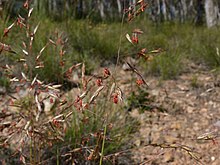
Vaccinium is a common and widespread genus of shrubs or dwarf shrubs in the heath family (Ericaceae). The fruits of many species are eaten by humans and some are of commercial importance, including the cranberry, blueberry, bilberry (whortleberry), lingonberry (cowberry), and huckleberry. Like many other ericaceous plants, they are generally restricted to acidic soils.

The stamen is the pollen-producing reproductive organ of a flower. Collectively the stamens form the androecium.
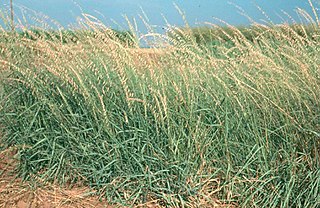
Bouteloua curtipendula, commonly known as sideoats grama, is a perennial, short prairie grass that is native throughout the temperate and tropical Western Hemisphere, from Canada south to Argentina.

Eupomatia is a genus of three flowering shrub species known to science, of the Australian continent ancient family Eupomatiaceae. The Eupomatiaceae have been recognised by most taxonomists and classified in the plant order Magnoliales. The three species of shrubs or small trees grow naturally in the rainforests and humid eucalypt forests of eastern Australia and New Guinea. The type species Eupomatia laurina was described in 1814 by Robert Brown.

Lolium perenne, common name perennial ryegrass, English ryegrass, winter ryegrass, or ray grass, is a grass from the family Poaceae. It is native to Europe, Asia and northern Africa, but is widely cultivated and naturalised around the world.

Chionochloa is a genus of tussock grass in the family Poaceae, found primarily in New Zealand with one known species in New Guinea and another on Lord Howe Island. Some of the species are referred to as snowgrass.
This glossary of botanical terms is a list of definitions of terms and concepts relevant to botany and plants in general. Terms of plant morphology are included here as well as at the more specific Glossary of plant morphology and Glossary of leaf morphology. For other related terms, see Glossary of phytopathology and List of Latin and Greek words commonly used in systematic names.
Rytidosperma caespitosum, known by various common names including common wallaby-grass, ringed wallaby-grass, and white-top, is a species of grass native to southern parts of Australia.

Calostemma is a small genus of herbaceous, perennial and bulbous plants in the Amaryllis family, commonly known as Wilcannia Lily. It consists of three species endemic to Australia, where they are distributed in arid regions with summer precipitation.
Plinthanthesis is a genus of Australian plants in the grass family.

Dianella revoluta, commonly known as blueberry lily, blue flax-lily, or black-anther flax-lily, a species of flowering plant in the family Asphodelaceae and is endemic to, and widespread in Australia. It is a tufted, perennial herb with grass-like leaves and up to nine blue or violet flowers with six tepals, and stamens with bright yellow filaments and pale brown to almost black anthers.

Rytidosperma is a genus of plants in the grass family. Most of the species occur in Australasia, with a few in insular Southeast Asia, southern South America, and certain islands of the Pacific. Several are known by the general common name wallaby grass.
Rytidosperma pumilum, also known as feldmark grass, is a species of grass in the family Poaceae. It is found in Australia and New Zealand.
Festuca contracta, commonly known as tufted fescue or land tussac, is a species of true grass (Poaceae). It is native to many subantarctic islands in, and the coasts bordering, the Southern Ocean. The specific epithet comes from the Latin contractus, with reference to the inflorescence.
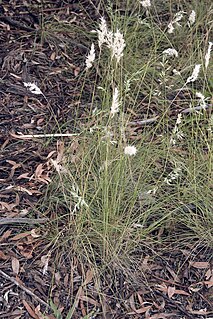
Rytidosperma setaceum, known by various common names including small-flowered wallaby-grass, mulga- or bristly wallaby-grass, is a species of grass native to Australia. Originally described by Robert Brown under the name Danthonia setacea, it was transferred into Austrodanthonia by Hans Peter Linder in 1993 and finally Rytidosperma in 2011.
Rytidosperma unarede is a grass in the family Poaceae. The specific epithet is the Māori name unarede recorded by Raoul when the plant was first described in 1844.
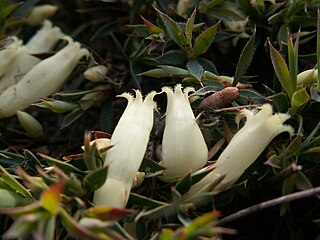
Astroloma pallidum, commonly known as kick bush, is usually a small, compact shrub in the family Ericaceae. The species is endemic to south-western Western Australia.
Caladenia cremna, commonly known as Don's spider orchid, is a plant in the orchid family Orchidaceae and is endemic to a small area in Victoria. It is a rare ground orchid with a single hairy leaf and a single yellow flower with red striations.
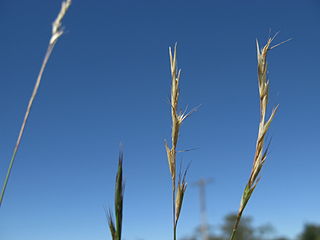
Rytidosperma racemosum or wallaby grass, is a species of grass found in New Zealand and southern and eastern Australia. A widespread plant, it is found in many parts of Australia, apart from the most arid sites. The specific epithet racemosa is derived from the Latin for bearing racemes. The grass may grow up to 0.6 m tall.

Carpha alpina, commonly known as small flower-rush, is a tufted perennial sedge from the family Cyperaceae. It is found primarily in south-east Australia and both islands of New Zealand, but also in Papua New Guinea.
